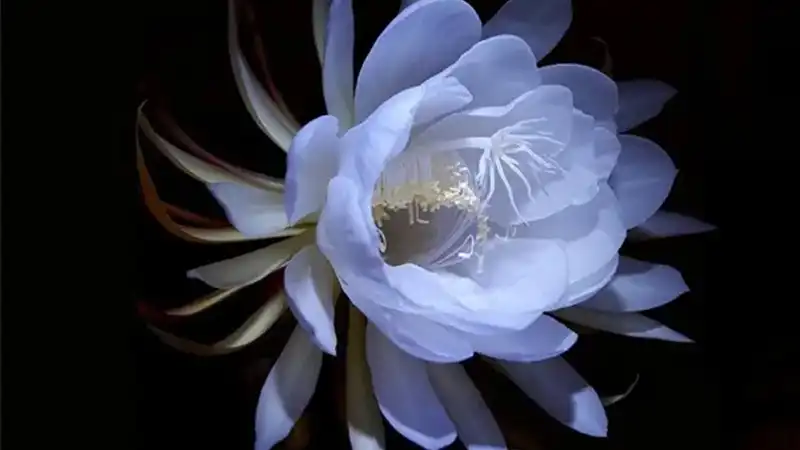
The Queen of the Night flower appears to be nothing less than Cinderella with its white hues, and you only get to see it under the moonlight. It belongs to the family of cacti and is a rare type of flower that only blooms one night, once a year. The nocturnal nature of the flower makes it ideal for moon gardens.
Additionally, this ephemeral flower is also considered a symbol of fortune as it is believed that it attracts abundance, augments health & career success, and enhances prosperity. Thus, many believers like to adorn their house gardens, bedrooms, or carry custom keychains with them.
Fortunately, you do not have to visit a night garden to witness the enchanting site of the night queen flower, as we have brought it all to your screens. With us, indulge yourself as we present a detailed insight into this rare beauty.
Facts about Queen of the Night
Though it belongs to the cacti family, planting a queen of the night flower is similar to growing a tropical plant. Although the flower blooms only once a year, you can easily take care of the plant at home. Usually blooming in a pearl white shade, it holds a dignified place among the list of white flowers by many floraphiles.
| Scientific Name | Epiphyllum oxypetalum |
| Family | Cactaceae |
| Common Nicknames | Lady of the Night Night Queen Night Blooming Cereus Orchid Cactus Leaf cactus Climbing cacti Dutchman’s pipe cactus |
| Plant Type | Evergreen succulent, jungle cactus |
| Colors | Red, white, yellow, creme, purple, pink |
| Height | Up to 10 feet (ca. 3 m) tall outdoors and up to 6 feet (1.83 m) tall indoors |
| Native area | Mexico, Central America, and South America |
| Hardy Zones (USDA) | 10-11 |
| Sun Exposure | Partial shade |
| Soil Type | Well-drained aerated soil |
| Soil pH | 5.5 to 6.5 (slightly acidic) |
| Watering | When the top few inches of soil is dry, or once a week |
| Bloom Time: | Late spring into summer, Night blooming |
Types of Queen of the Night Flowers
These royal beauties have different variants, specifically depending on the color of the flower they produce. The common six types of Queen of the Night flowers are:
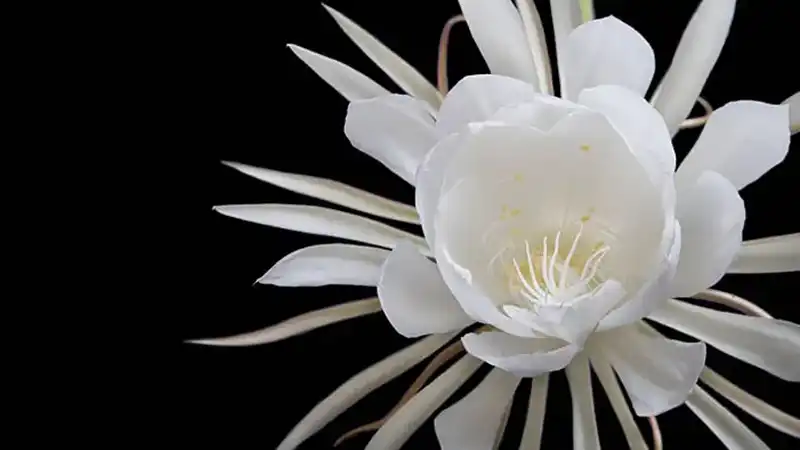
- White: White is the most common color for Queen of the Night flowers. The petals are pure white, giving the flower an ethereal and elegant appearance.
- Red: The hybrid varieties may produce red-colored flowers. The bright red blooms are quite striking and add a bold splash of color to the garden.
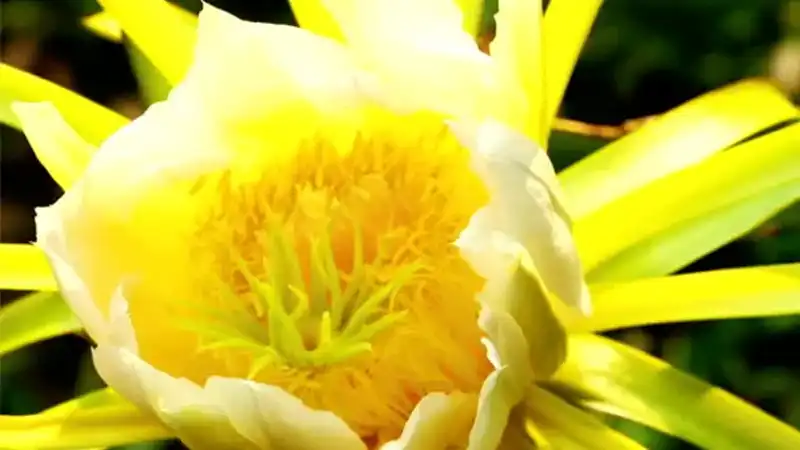
- Yellow: Some varieties may have a yellowish or golden hue in the center of the flower. This adds a touch of warmth and contrast to the overall white bloom.
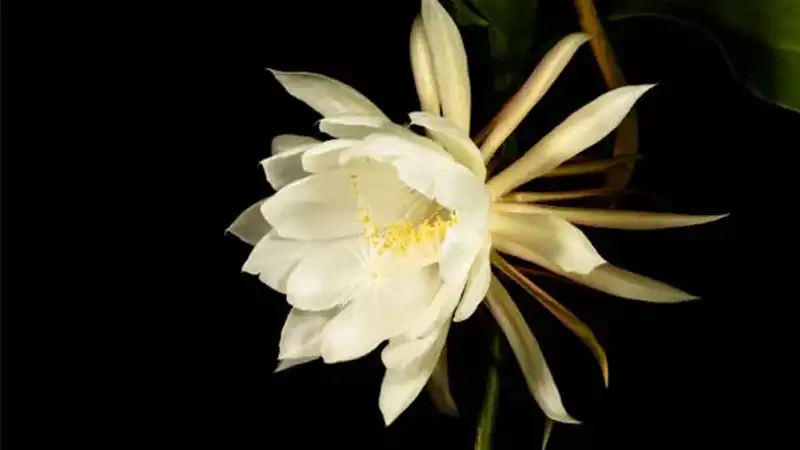
- Cream: This variant has a softer and more subdued look compared to pure white blooms.
- Purple: The rare deep purple blooms stand out dramatically against the green foliage.
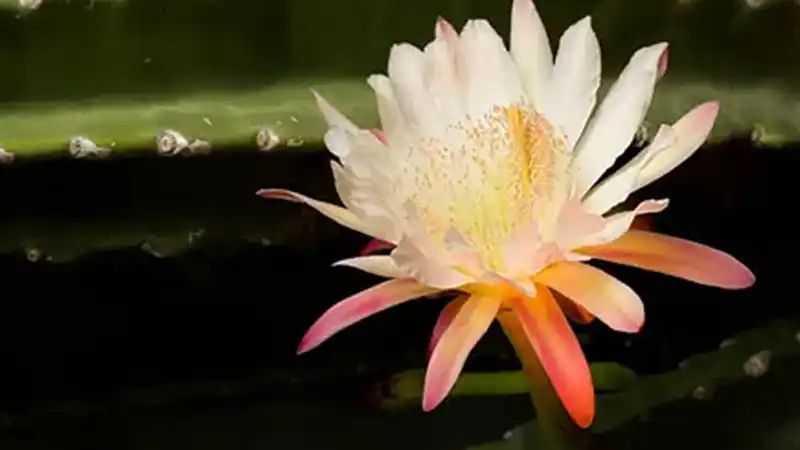
- Pink: Although less common, these are often a result of cross-breeding with other cacti, resulting in a delicate pink hue.
The calm aura and soothing appeal of these queens always leave everyone in a trance.
Fun Fact: Do not mistake the delicacy of these flowers as their weakness, because they are strong warriors that can fight off periods of drought as well.
Blooming Behavior and Pollination
The blooming behavior of the Queen of the Night Plant is a spectacle to behold. The flowers begin to open after sunset, gradually unfurling their petals to reveal the intricate floral structure. The blooming process peaks during the late hours of the night, attracting nocturnal pollinators such as moths and bats with their sweet fragrance.
The timing of the bloom is strategic, as it allows the flower to maximize pollination by nocturnal creatures. The pollinators are drawn to the flower’s nectar and, in the process, facilitate the transfer of pollen between flowers, ensuring successful reproduction.
How to Care For Queen of the Night Flower?

Don’t let the exotic and nocturnal nature of the plant scare you from growing your own. Here are some tips you can follow to grow queen night cactus on your own:
- Growth: Queen of the Night is a type of forest cactus that grows quickly if provided with the right atmosphere.
- Sunlight Requirements: Unlike most of the cacti, Queen Night Cactus does not require full sun. Instead, its ideal light requirement is indirect sunlight that mimics the natural habitat of the plant.
- Soil Conditions: The plant needs moist and well-aerated soil as it grows in the jungle treetops. Queen Of The Night Cactus Plant prefers slightly acidic soil with a pH between 5.5 to 6.5.
- Temperature: Since the plant’s natural habitat is the jungle, try recreating the environment for optimal growth of the Queen of the Night flower. Try to maintain the temperature between 50 °F (ca. 10 °C) to 90 °F (ca. 32 °C). If possible, invest in a humidifier and keep the humidity level above 50%.
- Fertilizer: Organic compost is ideal for the growth of the Queen of the Night plant, as it feeds on dead leaves and insects in its natural habitat. You can also opt for a fertilizer that is low on nitrogen, in case the flower won’t bloom.
- Potting: Since the plant requires airy soil, a clay pot is best suited for the plant rather than a plastic one. As the night flower is a natural epiphyte, you can install some wires or pipes it can climb onto.
- Water Routine: Belonging to the cactus family, it can store water and hence, does not require frequent watering. Water the plant just to prevent the soil from drying out, as excess water can kill the plant.
In colder temperatures, protect it from frost while still keeping it moist by spraying water. You can also keep a pebble-filled tray of water underneath the pot to retain the moisture.
When grown in their natural habitat, night queens usually grow as an epiphyte nesting other trees. When grown indoors, you may still notice the outgrowing shoots that typically wrap around tree branches in the wild.
Pests and Diseases Preying on Queen Of The Night Plant
Being natural cacti, these plants exhibit resistance to most pests. But it’s always better to be cautious than ill. So, keep an eye out for these pests and diseases that may attack your plant:
- Mealybugs: Mealybugs are cotton-like pests that feed on plant juices. Apply insecticidal soap or use a cotton swab to apply alcohol on the leaves.
- Spider mites: Tiny arachnids called spider mites feed on the sap of plants to survive. Mist the leaves of the plant frequently or add some mite predators such as ladybugs.
- Fungal diseases: These plants are prone to fungal diseases like powdery mildew and anthracnose. They cause dark, sunken blemishes on leaves, stems, and flowers. To avoid this, don’t overwater and keep the plant well-ventilated.
- Root rot: It’s another damage that occurs from overwatering or improper draining. Simply ensure to plant it in loosely potted, well-drained soil.
Growing any plant requires a commitment to keep it safe and sound from any disease or infection. Offer this queen lots of love and care, and in turn, she will give your garden an aura of royalty.
How to Propagate Queen of the Night Flower?
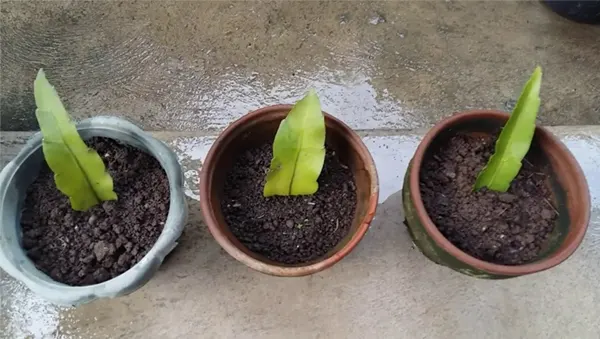
The propagation process for this plant is pretty easy compared to caring for it. The primary propagation method used is cutting and division. Here are the steps you can follow to plant a new Queen of the Night plant:
- Cut a healthy 4-6 inch long stem with no flowers or buds.
- Dip the stem into the rooting hormone with the cut end facing downwards.
- Keep it in a cool and dark place for a few days to develop roots.
- Prepare a pot slightly larger than the stem, and fill it with a well-draining potting mix.
- Make a hole in the center and plant the cutting.
- Fill the gaps with more soil and tap gently.
- Keep it in a humid area to develop roots quickly.
- Do not water the plant for the next two weeks, allowing it to settle.
- Once you notice roots springing from it, shift it to a bigger pot and continue with the regular care routine.
Repotting Queen of the Night Flower in the Future
The first and foremost thing you should remember is to only re-pot the plant when it has outgrown the container. Repotting unnecessarily and frequently can damage the roots, making the plant weak.
Moreover, it is required to water the plant thoroughly to loosen the roots, making it easier to change its container. When choosing a new pot, always go for one or two sizes bigger, depending on the plant’s pace of growth.
Avoid frequent watering for the starting weeks to allow the plant to adjust to its new surroundings. Do not provide any kind of fertilization till the roots have completely settled in.
Following these steps and precautions from the very start will undoubtedly bloom your queen night flower into an elegant beauty.
Potential Health Benefits
Queen of the Night is not just an exotic beauty, but it also possesses some remarkable medicinal properties. The plant has been part of some Asian and tropical American cultures for ages due to its diverse health benefits. Here is how you can use the plant for your well-being:
- Cure for Insomnia: Traditionally, Queen of the Night’s sedative nature has been used to cure sleeping disorders or insomnia. But keep in mind not to use it without expert advice, as the dosage amount has to be monitored strictly.
- Pain Relief: Extract of the plant is used to alleviate pain like joint pain and menstrual cramps.
- Remedy for Cough: In many cultures, the flower, or flower buds are used externally for treating cough, fever, tuberculosis, and gastritis.
- Treatment for Wounds and Boils: The leaf extracts of Lady of the Night Plant have antimicrobial properties and hence are suited for treating external wounds as it aids the healing process.
Reaching here, it is proved that these ladies are not simply pleasant to the eyes, but pleasurable to the body as well. Its healing elements make it a permanent addition to the list of medicinal plants.
Symbolic Meaning and Spiritual Significance of The Night Flower
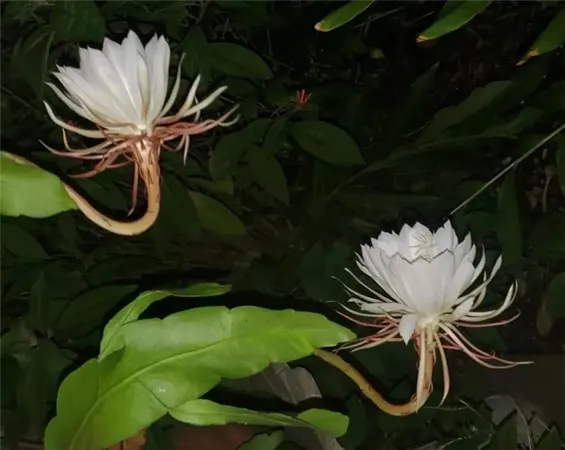
This nocturnal bloom holds symbolic meanings and spiritual significance in various cultures and belief systems. Here are some of the symbolic meanings associated with these mystical flowers:
- Mystery and Ephemeral Beauty: The nocturnal blooming habit of the Night Queen Flower symbolizes mystery and secrets. Its fleeting beauty that lasts only for a night before fading away represents the transient nature of life.
- Transformation and Renewal: The process of blooming at night and closing during the day symbolizes transformation and renewal. It signifies the cycle of life, death, and rebirth, reminding us of the constant changes and growth in our lives.
- Feminine Energy: The flower’s name, “Queen of the Night,” evokes images of royalty and feminine power. It is associated with qualities such as grace, beauty, resilience, and nurturing nature.
- Sacredness and Rituals: In certain cultures, the Queen of the Night cactus plant is considered sacred and is used in rituals and ceremonies. It symbolizes purity, divine presence, and the connection between the physical and spiritual realms.
With all this positive energy radiating from Queen Night cactus, it is impossible for one to not add it to their collection. Be it an indoor center table or a pathway border, these moon queens shine brightly even in the darkest of nights.
Conclusion
The Queen of the Night is known for its unique scent and nocturnal nature. Though not much is known about the plant even today, experiencing its full bloom is a magnificent sight.
This cactus can add the much-needed exotic touch to your garden but keep in mind that this unique plant requires some special care or else it won’t survive.
Is the Queen of the Night flower rare?
Queen of the Night is a unique kind of flower that blooms only one night a year. Seeing the flower in full bloom at night is a rare experience, as it wilts before the daylight.
What is the legend of the Queen of the Night flower?
Legend has it that Epiphyllum was once a daily-blooming flower goddess who fell for a young man named Weituo. The Jade Emperor, furious, broke their relationship, transforming the goddess into a flower that only opens at night. The young man, named Weituo, was sent to a temple to become a monk, forgetting his past life. Epiphyllum always saved her energy to bloom when Weituo goes out for water at night.
Where does the Queen of the Night flower grow?
South and Central America’s tropical rainforests, as well as southern Mexico, are the main residences of the queen of the night flower. Outside, mature plants can reach heights of up to 10 feet, while they reach only up to 6 feet indoors.
Can you eat the Queen of the Night flower?
Yes, the night queen flower is edible and non-toxic, often being used as a medicine for sore throats. However, an overdose may lead to nausea and stomachache.
Queen of the Night in Bloom by Desert Botanical Garden



